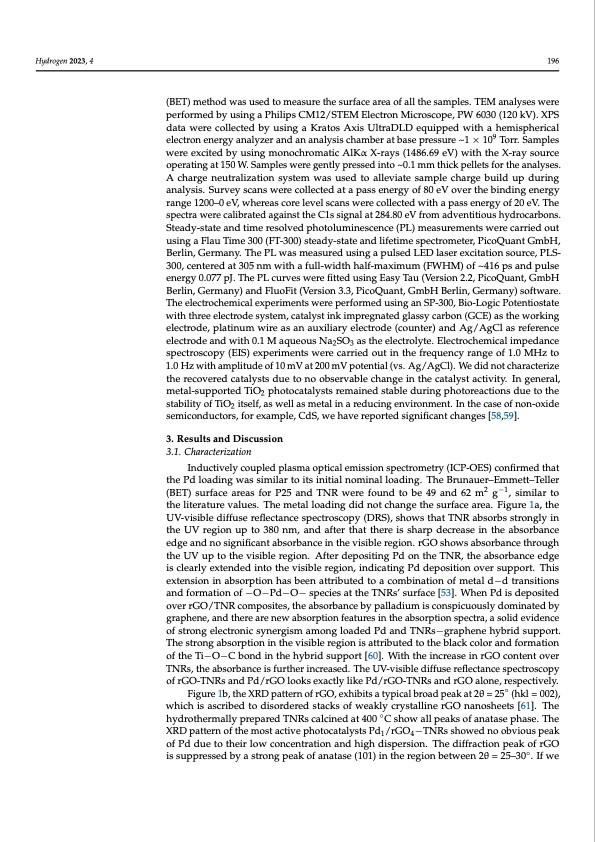
PDF Publication Title:
Text from PDF Page: 005
Hydrogen 2023, 4 196 (BET) method was used to measure the surface area of all the samples. TEM analyses were performed by using a Philips CM12/STEM Electron Microscope, PW 6030 (120 kV). XPS data were collected by using a Kratos Axis UltraDLD equipped with a hemispherical electron energy analyzer and an analysis chamber at base pressure ~1 × 109 Torr. Samples were excited by using monochromatic AlKα X-rays (1486.69 eV) with the X-ray source operating at 150 W. Samples were gently pressed into ~0.1 mm thick pellets for the analyses. A charge neutralization system was used to alleviate sample charge build up during analysis. Survey scans were collected at a pass energy of 80 eV over the binding energy range 1200–0 eV, whereas core level scans were collected with a pass energy of 20 eV. The spectra were calibrated against the C1s signal at 284.80 eV from adventitious hydrocarbons. Steady-state and time resolved photoluminescence (PL) measurements were carried out using a Flau Time 300 (FT-300) steady-state and lifetime spectrometer, PicoQuant GmbH, Berlin, Germany. The PL was measured using a pulsed LED laser excitation source, PLS- 300, centered at 305 nm with a full-width half-maximum (FWHM) of ~416 ps and pulse energy 0.077 pJ. The PL curves were fitted using Easy Tau (Version 2.2, PicoQuant, GmbH Berlin, Germany) and FluoFit (Version 3.3, PicoQuant, GmbH Berlin, Germany) software. The electrochemical experiments were performed using an SP-300, Bio-Logic Potentiostate with three electrode system, catalyst ink impregnated glassy carbon (GCE) as the working electrode, platinum wire as an auxiliary electrode (counter) and Ag/AgCl as reference electrode and with 0.1 M aqueous Na2SO3 as the electrolyte. Electrochemical impedance spectroscopy (EIS) experiments were carried out in the frequency range of 1.0 MHz to 1.0 Hz with amplitude of 10 mV at 200 mV potential (vs. Ag/AgCl). We did not characterize the recovered catalysts due to no observable change in the catalyst activity. In general, metal-supported TiO2 photocatalysts remained stable during photoreactions due to the stability of TiO2 itself, as well as metal in a reducing environment. In the case of non-oxide semiconductors, for example, CdS, we have reported significant changes [58,59]. 3. Results and Discussion 3.1. Characterization Inductively coupled plasma optical emission spectrometry (ICP-OES) confirmed that the Pd loading was similar to its initial nominal loading. The Brunauer–Emmett–Teller (BET) surface areas for P25 and TNR were found to be 49 and 62 m2 g−1, similar to the literature values. The metal loading did not change the surface area. Figure 1a, the UV-visible diffuse reflectance spectroscopy (DRS), shows that TNR absorbs strongly in the UV region up to 380 nm, and after that there is sharp decrease in the absorbance edge and no significant absorbance in the visible region. rGO shows absorbance through the UV up to the visible region. After depositing Pd on the TNR, the absorbance edge is clearly extended into the visible region, indicating Pd deposition over support. This extension in absorption has been attributed to a combination of metal d−d transitions and formation of −O−Pd−O− species at the TNRs’ surface [53]. When Pd is deposited over rGO/TNR composites, the absorbance by palladium is conspicuously dominated by graphene, and there are new absorption features in the absorption spectra, a solid evidence of strong electronic synergism among loaded Pd and TNRs−graphene hybrid support. The strong absorption in the visible region is attributed to the black color and formation of the Ti−O−C bond in the hybrid support [60]. With the increase in rGO content over TNRs, the absorbance is further increased. The UV-visible diffuse reflectance spectroscopy of rGO-TNRs and Pd/rGO looks exactly like Pd/rGO-TNRs and rGO alone, respectively. Figure 1b, the XRD pattern of rGO, exhibits a typical broad peak at 2θ = 25◦ (hkl = 002), which is ascribed to disordered stacks of weakly crystalline rGO nanosheets [61]. The hydrothermally prepared TNRs calcined at 400 ◦C show all peaks of anatase phase. The XRD pattern of the most active photocatalysts Pd1/rGO4−TNRs showed no obvious peak of Pd due to their low concentration and high dispersion. The diffraction peak of rGO is suppressed by a strong peak of anatase (101) in the region between 2θ = 25–30◦. If wePDF Image | Enhanced Photoreforming of Oxygenates

PDF Search Title:
Enhanced Photoreforming of OxygenatesOriginal File Name Searched:
hydrogen-04-00014-v2.pdfDIY PDF Search: Google It | Yahoo | Bing
Salgenx Redox Flow Battery Technology: Power up your energy storage game with Salgenx Salt Water Battery. With its advanced technology, the flow battery provides reliable, scalable, and sustainable energy storage for utility-scale projects. Upgrade to a Salgenx flow battery today and take control of your energy future.
| CONTACT TEL: 608-238-6001 Email: greg@infinityturbine.com | RSS | AMP |